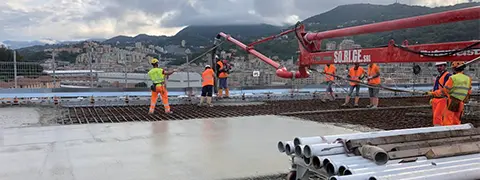

How the admixtures industry can assist in low carbon concrete production
Innovative admixture technologies driving reductions in embodied carbon content for sustainable concrete
The admixtures play a key role in reducing the embodied carbon content of concrete through innovative products such as Low Carbon Concrete Admixtures (LCCA). These formulations optimise hydration, enabling lower cement content or higher dosage of Supplementary Cementitious Materials (SCM) while maintaining high performance. The use of Mapecube 60W admixtures allows CO₂ reductions of up to 35%. Further strategies include using reclaimed aggregates, dry concrete recycling, and macro synthetic fibres. Together, these innovations support the construction sector’s path toward Net Zero by 2050.
Recent developments from the admixtures industry have included a new type of admixture with the unofficial title of Low Carbon Concrete Admixtures (LCCA). These new admixtures work in conjunction with a traditional High Range Water Reducing Admixture (HRWRA) to further increase the performance of the concrete by optimising the hydration process. The main focus for LCCA is to either further reduce the cementitious content, or to increase the % replacement of supplementary cementitious material (SCM), or a combination of both.
LCCA’s such as Mapei’s Mapecube 60W will have a small reduction in the free water content of the concrete, but not such that they detrimentally effect the concrete rheology. LCCA’s are not currently defined by any harmonised standard, so in order to provide them as a CE marked product they incorporate a small amount of water reduction to comply with the requirements of BS EN 934-2 Table 2 (water reducing admixture). A good example of innovation being ahead of standardisation.

In the first example, a concrete mix with a 350kg/m3 CIIIA (40% GGBS replacement) was used as the reference mix, this was compared to 3 separate mixes incorporating Mapecube 60W @ 0.80% -:
- 320kg/m3 CIIIA with 40% GGBS replacement
- 350kg/m3 CIIIA with 50% GGBS replacement
- 350kg/m3 CIIIB with 70% GGBS replacement


Although this paper so far has focussed on the reduction of CO2 by optimising the composition of the cementitious component of the concrete, we should not forget the contribution of the aggregate content.The admixtures industry already has products such as Re-Con AGG 100 that can permit the use of previously less desirable aggregate sources in concrete. This will permit the utilisation of more local sources and see a direct CO2 benefit from reduced transport distances. It’s generally recognised that up to 5% of concrete produced globally is returned to the production plant unused. This places an immense challenge to the concrete producer on how to deal with this waste, traditional wet concrete reclaimers have been used for many years, however, although the aggregate fraction is easily reclaimed and re-used, the resulting cementitious and fine fines slurry has proved more challenging. It is not unusual to see a mothballed wet concrete reclaimer & filled in slurry pit at a concrete plant.
Mapei S.p.A have recently launched their new innovative & patented dry reclaiming system, Re-Con Dry Reclaimer, that, when used in conjunction with Re-Con Zero L/A, is able to convert fresh returned concrete, within minutes, into a totally re-usable earth dry granular material without utilising any water or giving rise to the production of any subsequent cementitious slurry. This granular material can be stored and re-used directly at the concrete plant as part of the coarse aggregate content of subsequent concrete, without any detriment to performance. This provides the opportunity for a concrete plant to produce near zero, d potentially zero concrete waste with the resultant environmental and economic benefits.

(1) All CO2e figures are based on the latest edition of MPA Fact Sheet 18 & are factory gate figures, for Dynamon Easy 31 (UK) the value is that defined by EFCA (EPD-EFC-20210198-IBG1-EN, for Mapecube 60W the value is defined by the Mapei EPD (EPD International AB S-P-09427). The numbers shown are only the sum of the cementitious content and any admixtures, no allowance for aggregate content contribution, energy or transport are included.
This article was published in Concrete magazine, (October 2025) which we would like to thank.










